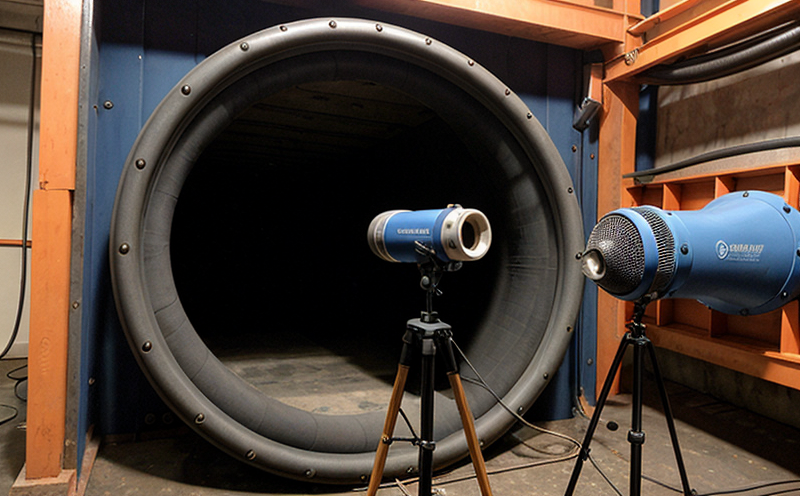ISO 16826 Ultrasonic Testing Using Shear Waves
The ISO 16826 standard specifies the principles, methods, and procedures for ultrasonic testing using shear waves in materials. This non-destructive testing (NDT) method is crucial for evaluating the integrity of materials and structures without causing damage. Shear wave ultrasonic testing (UT) is widely used in industries such as aerospace, automotive, construction, and manufacturing to detect flaws like cracks, porosity, and other anomalies.
The shear waves used in this method travel perpendicular to the direction of sound propagation. This allows for highly accurate detection of defects that are oriented at various angles relative to the surface being inspected. The technique leverages a transducer to generate high-frequency ultrasonic pulses which interact with the material's internal structure, reflecting back when they encounter changes in density or composition.
According to ISO 16826, the shear wave UT method is particularly effective for inspecting thick sections of materials where surface inspections alone may not be sufficient. The standard provides detailed guidelines on equipment selection, transducer calibration, and testing procedures to ensure consistent and reliable results. Compliance with this international standard ensures that the testing process adheres to recognized best practices.
Before conducting shear wave ultrasonic tests, it is essential to prepare the specimens properly. This involves cleaning the surface, ensuring its flatness, and sometimes applying coupling agents like water or a gel to enhance signal transmission. Specimen preparation plays a critical role in obtaining accurate and repeatable results.
The testing equipment typically includes a shear wave transducer connected to an ultrasonic flaw detector. The instrument processes the reflected signals from the specimen, generating a waveform display that can be analyzed for defect indications. The standard specifies criteria for interpreting these waveforms, including amplitude, phase shift, and shape characteristics.
| Industry | Application |
|---|---|
| Aerospace | Inspecting critical components like turbine blades and landing gears for cracks. |
| Automotive | Evaluating engine blocks, cylinder heads, and other heavy-duty castings for internal flaws. |
| Mechanical Engineering | Detecting defects in large cast or forged parts used in machinery. |
The ISO standard also sets out acceptance criteria that specify the maximum allowable defect sizes and types. Compliance with these criteria is vital for ensuring product quality and safety, especially when dealing with critical components where even minor flaws could lead to catastrophic failures.
Why It Matters
The importance of ISO 16826 ultrasonic testing using shear waves cannot be overstated. Non-destructive testing methods like this one are essential for maintaining the integrity and safety of materials used in various industries. By employing this technique, manufacturers can avoid costly rework or replacement of defective parts while ensuring that their products meet stringent quality standards.
The ability to inspect thick sections without causing damage is a significant advantage of shear wave UT. This makes it particularly useful for inspecting large structures like aircraft fuselages, ship hulls, and oil rig components where surface inspections might miss internal defects. The precision achieved through this method ensures that even small flaws are detected early in the production process.
Compliance with ISO 16826 also enhances the reliability of testing results by providing a standardized approach across different laboratories and regions. This consistency is crucial for quality assurance programs and regulatory compliance, particularly in high-risk industries where safety is paramount.
Industry Applications
- Aerospace: Inspecting critical components like turbine blades and landing gears for cracks.
- Automotive: Evaluating engine blocks, cylinder heads, and other heavy-duty castings for internal flaws.
- Mechanical Engineering: Detecting defects in large cast or forged parts used in machinery.
The shear wave UT method is particularly effective for inspecting thick sections of materials where surface inspections alone may not be sufficient. The standard provides detailed guidelines on equipment selection, transducer calibration, and testing procedures to ensure consistent and reliable results.
Environmental and Sustainability Contributions
Compliance with ISO 16826 ultrasonic testing using shear waves contributes significantly to environmental sustainability by promoting the use of non-destructive methods that preserve valuable resources. By detecting defects early in the production process, this method helps minimize waste and reduce the need for rework or replacement of defective parts.
The precision achieved through this technique ensures that even small flaws are detected early, which can lead to more efficient manufacturing processes and reduced energy consumption during production. Additionally, by ensuring product quality and safety, this testing method supports longer service life for products, reducing the frequency of replacements and associated environmental impacts.





